-
@dennypage said in NUT package:
If you are using usb (usbhid-ups), I believe the answer is yes, they are reset every time. See the Extra Arguments section in the NUT documentation.
For entertainment value, I took a quick look... with usbhid it's not that the value is reset each time, it's that the value must be sent to the UPS to perform the shutdown.
Here's some relevant info from the spec:
DelayBeforeReboot
Writing this value immediately shuts down (i.e., turns off) the output for a period equal to the indicated number of seconds in DelayBeforeReboot, after which time the output is started. If the number of seconds required to perform the request is greater than the requested duration, then the requested shutdown and startup cycle shall be performed in the minimum time possible, but in no case shall this require more than the requested duration plus 60 seconds. If the startup should occur during a utility failure, the startup shall not occur until the utility power is restored.When read, DelayBeforeReboot returns the number of seconds remaining in the countdown, or –1 if no countdown is in progress.
DelayBeforeStartup
Writing this value starts the output after the indicated number of seconds in DelayBeforeStartup. Sending this command with 0 causes the startup to occur immediately. Sending this command with –1 aborts the countdown. If the output is already on at the time the countdown reaches 0, nothing happens. On some systems, if the USB driver on the device side is restarted while a startup countdown is in effect, the countdown is aborted. If the countdown expires during a utility failure, the startup shall not occur until the utility power is restored. Writing this value overrides the effect of any DelayBeforeStartup countdown or DelayBeforeReboot countdown in progress.When read, DelayBeforeStartup returns the number of seconds remaining in the countdown, or –1 if no countdown is in progress.
DelayBeforeShutdown
Writing this value shuts down (i.e., turns off) either the output after the indicated number of seconds, or sooner if the batteries become depleted. Sending this command with 0 causes the shutdown to occur immediately. Sending this command with –1 aborts the countdown. If the system is already in the desired state at the time the countdown reaches 0, there is no additional action (i.e. there is no additional action if the output is already off). On some systems, if the USB driver on the device side is restarted while a shutdown countdown is in effect, the countdown may be aborted. Writing this value overrides any DelayBeforeShutdown countdown already in effect.When read, DelayBeforeShutdown will return the number of seconds remaining until shutdown, or –1 if no shutdown countdown is in effect.
-
Recently I started getting several emails a minute "UPS myups battery is low". The UPS is a few years old so I replaced the battery and restarted the service.
I am still getting the error messages even though it shows 100% battery. I'm at a loss to debug this further, I've tried adding
battery.charge.low: 10to the ups.conf and restarting but it seems to be getting ignored.
Here's the output from
upsc "myups"battery.charge: 100.0 battery.charge.low: 15 battery.date: 2008-06-25 battery.runtime: 120.0 battery.runtime.low: 300 battery.voltage: 12.7 battery.voltage.nominal: 12.0 device.mfr: APC device.model: Back-UPS ES 750 device.serial: 123456 device.type: ups driver.name: apcupsd-ups driver.parameter.pollinterval: 60 driver.parameter.port: 10.10.1.1 driver.parameter.synchronous: no driver.version: 2.7.4 driver.version.internal: 0.04 input.sensitivity: M input.transfer.high: 139.0 input.transfer.low: 92.0 input.transfer.reason: No transfers since turnon input.voltage: 120.0 input.voltage.nominal: 120 ups.date: 2021-11-29 ups.firmware: 841.I2 .D USB FW:I2 ups.id: UPS ups.load: 14.0 ups.mfr: APC ups.model: Back-UPS ES 750 ups.realpower.nominal: 450.0 ups.serial: 123456 ups.status: OL LB ups.test.result: NO ups.time: 09:07:42Can anyone provide any suggestions as to stopping the multiple email error messages?
-
@mike123 said in NUT package:
.... to stopping the multiple email error messages?
By telling your UPS that the battery has changed.
Dono how you can do this with NUT, but you could download the APC's MAC or,Windows client app, and use that to 'inform' the UPS that a battery change has occurred.Btw : this isn't probably the optimal solution, but this what I have done in the past.
-
Thanks, problem solved!
It never occurred to me that the UPS firmware had a battery "best before" date. The APC Powerchute software let me reset the battery date and my battery runtime magically went up from 120 to 1500. I guess it didn't want me to rely on what it thought was a 13 year old battery.
-
I bought a PowerWalker VFI 1000T it uses the Winpower client on Windows which works fine, but on pfsense it doesn't really.
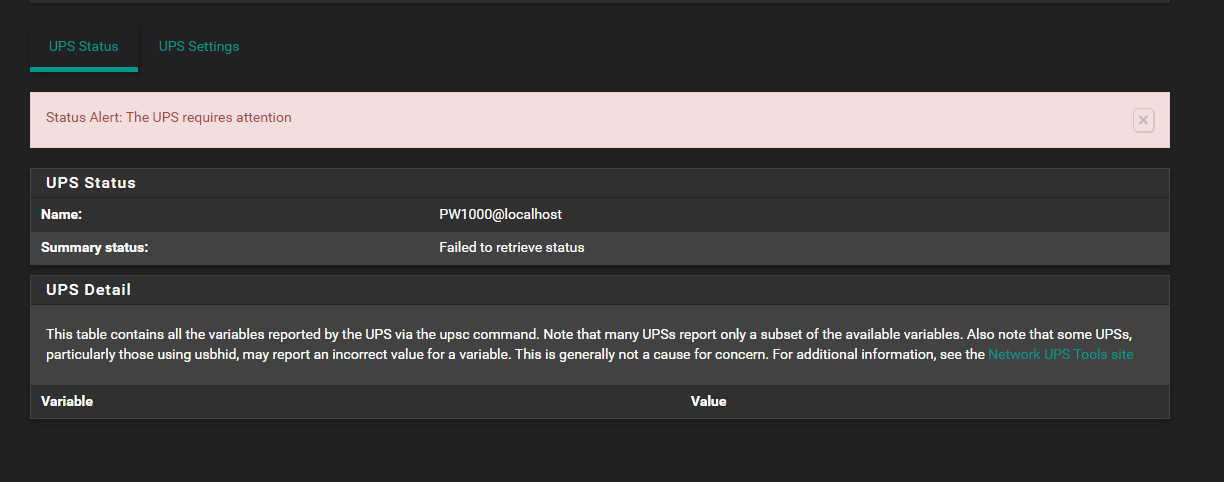
I don't know if the upsname is important, but its named PW1000 in Winpower so i used that.
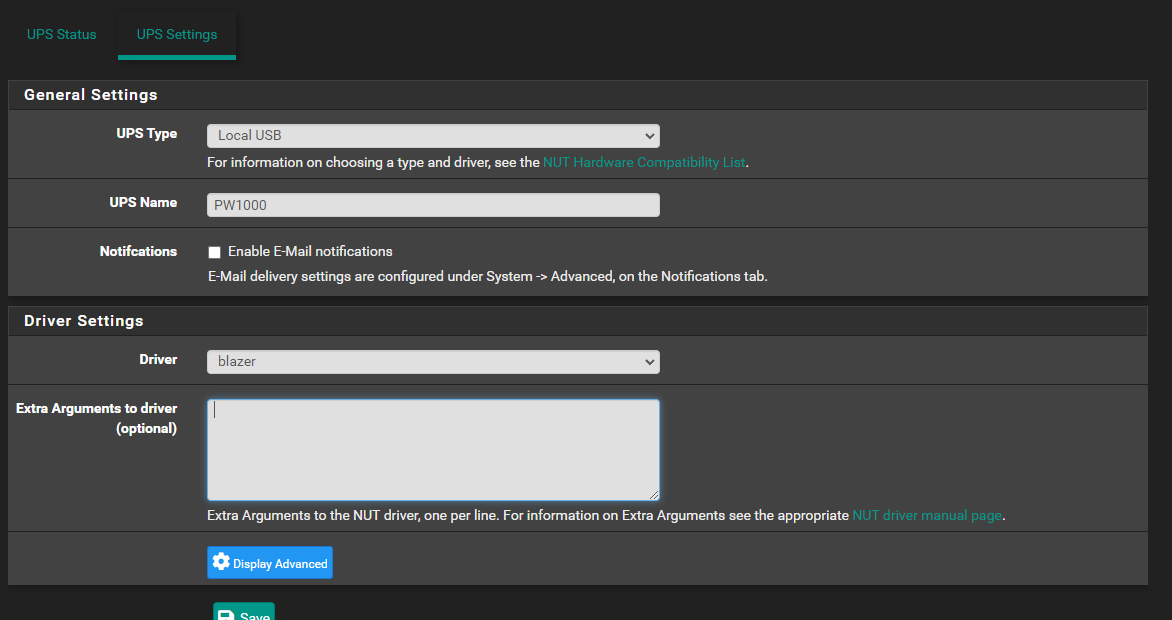
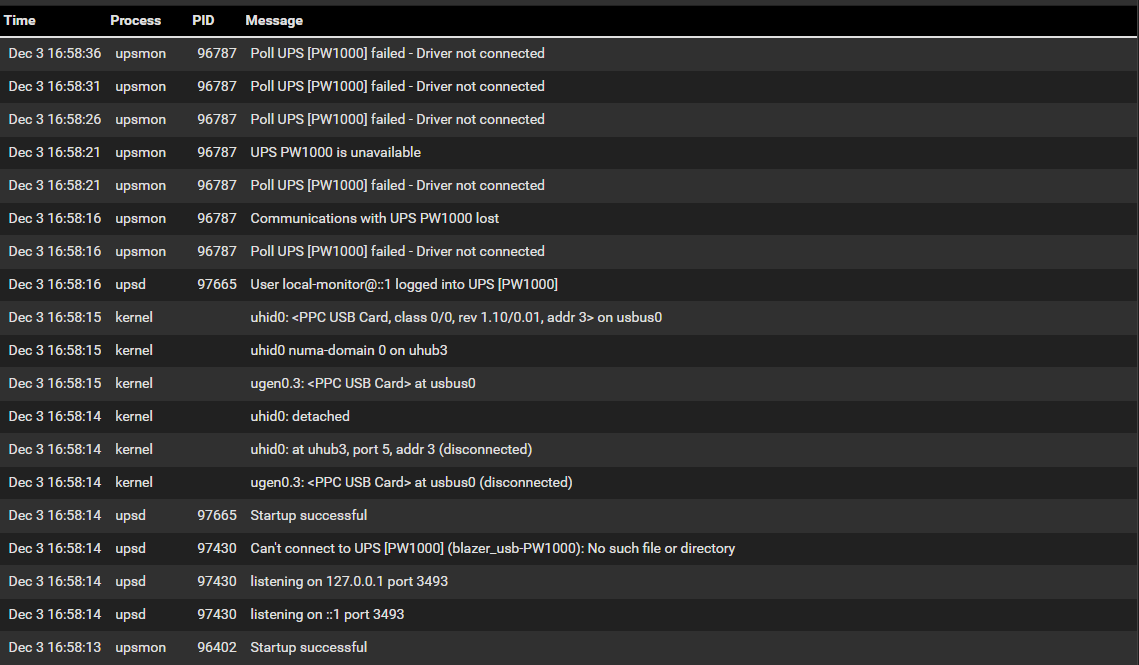
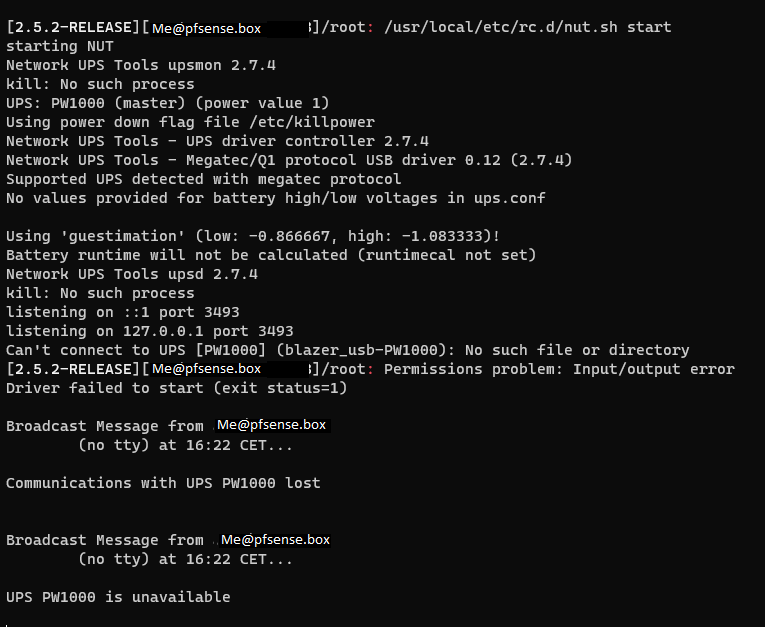
i have tried multiple combinations of restarting, uninstalling and reinstalling the package, different usb Ports which have been suggested for other similar problems. Extra arguments norating, novendor, pollinterval=10. But none of this helped or even changed behaviour.
Can you help me with this?
-
@umbraatrox said in NUT package:
PowerWalker VFI 1000T it uses the Winpower client on Windows which works fine, but on pfsense it doesn't really.
Here is my list of suggestions...
- Have you rebooted since first plugging the usb connection in? Some of the USB kernel drivers require that. Do this first.
- Try the usbhid driver and confirm that it does not work before trying any other driver.
- Try the nutdrv_qx driver.
- Try the blazer driver (the one that you have already tried).
- Some devices create special device names in FreeBSD because they are actually serial emulators. You can generally discover the port by looking through the system log (dmesg).
- Some of the more boutique drivers may require you to explicitly specify several "optional" parameters, like port, vendor it, product id, sub driver, etc. You have to figure this out by out by trial and error or contacting the vendor.
- Ask for help on the NUT mailing list.
-
Also cross check the UPS model with this list : https://networkupstools.org/stable-hcl.html and tips / trucks you can find at the NUT support pages.
-
I tried to enable SSL, and I got this:
Dec 12 16:45:58 pfsense upsd[12551]: upsd.conf: invalid directive CERTFILE /etc/ssl/nut_cert/upsd.pem
Dec 12 16:45:58 pfsense upsd[12551]: upsd.conf: invalid directive CERTREQUEST REQUIRE
Dec 12 16:45:58 pfsense upsd[12551]: upsd.conf: invalid directive DISABLE_WEAK_SSL true
I think this means SSL support was not compiled into the package. -
@gooberpatrol66 said in NUT package:
I think this means SSL support was not compiled into the package.
I believe you are correct, there is no certificate support.
-
I installed the package, connected the USB socket to an APC Back-UPS BX2200MI, in the console I see that it recognizes it, but then in Services/UPS/Status I see:
"Failed to retrieve status" -
@whitetiger-it Generally this is a permissions problem with initial USB install. Addressed by Rebooting or by unplugging and re-plugging the USB.
-
@dennypage
Perfect, now it shows.
Thank you.How can I now manage the shutdown of pfSense and the PCs-Servers in the network?
I should be able to define minutes and load limits, also in the clients installed on the PCs-Servers I should be able to define parameters to synchronize with the NUT package. -
@whitetiger-it said in NUT package:
How can I now manage the shutdown of pfSense and the PCs-Servers in the network?
I should be able to define minutes and load limits, also in the clients installed on the PCs-Servers I should be able to define parameters to synchronize with the NUT package.NUT will manage the shutdown for you. Unless you are familiar with NUT itself, and have a specific need to fix something that isn't working, I would recommend sticking with the default NUT parameters.
Remote access options are detailed in the second post.
-
I have been defeated by my recently acquired Tripplite Smart1500LCD.
 I put in the work.... My OCD is not about let me give up until my Amazon return window closes. I've read all 850 some posts of this thread multiple times. I've read everything google has thrown at me regarding NUT and Smart1500LCD. I've read NUT mailing list... Github... Literally everything I can find that's relevant.
I put in the work.... My OCD is not about let me give up until my Amazon return window closes. I've read all 850 some posts of this thread multiple times. I've read everything google has thrown at me regarding NUT and Smart1500LCD. I've read NUT mailing list... Github... Literally everything I can find that's relevant.The problem I'm having is I cant get the UPS to trigger pfSense to shutdown unless I use
ignorelboverride.battery.charge.low = 20 or override.battery.runtime.low = 300or I use theupsmon -c fsdcommand. When those commands initiate a shutdown, pfSense starts shutting down but triggers the UPS to shut down too fast before pfSense has a chance to fully shutdown. Then the UPS powers back up the outlets after about 20-30 seconds no matter if the main is on/off or no matter how much battery the UPS has left. Its as if the UPS isnt giving pfSense any shutdown command. The Smart1500LCD default battery.charge.low is suppose to be 50%. Its basically a dump UPS... Rides all the way to the battery dies. I even ran it down past 0%, after about an hour on 0% it shut down pfSense then started back up again pushing my switch until I turned main back on. I can not getoffdelay=60to work at all.There's a video on YouTube where someone with the same Smart1500LCD UPS got NUT working on debian. I've tried every setting in this thread with no luck. The settings I currently have below are the same settings from the YouTube vid. The video, and NUT mailing list say there is a issue with this UPS constantly disconnecting due to the USB and there is a patch for it that goes in
/etc/udev/rules.dbut when I look atdmesgI don't have a bunch of disconnects every 10 seconds like they are talking about. I only get a few when NUT starts then none after. Example below.igb0: link state changed to UP igb0.50: link state changed to UP igb0.20: link state changed to UP igb0.40: link state changed to UP igb0.10: link state changed to UP igb0.60: link state changed to UP ugen0.3: <Tripp Lite Tripp Lite UPS> at usbus0 (disconnected) uhid0: at uhub1, port 1, addr 3 (disconnected) uhid0: detached igb1: link state changed to UP ugen0.3: <Tripp Lite Tripp Lite UPS> at usbus0 uhid0 on uhub1 uhid0: <Tripp Lite Tripp Lite UPS, class 0/0, rev 1.10/0.09, addr 3> on usbus0 tun1: changing name to 'ovpns1' ovpns1: link state changed to UP pflog0: promiscuous mode enabled ugen0.3: <Tripp Lite Tripp Lite UPS> at usbus0 (disconnected) uhid0: at uhub1, port 1, addr 3 (disconnected) uhid0: detached ugen0.3: <Tripp Lite Tripp Lite UPS> at usbus0 uhid0 on uhub1 uhid0: <Tripp Lite Tripp Lite UPS, class 0/0, rev 1.10/0.09, addr 3> on usbus0 ugen0.3: <Tripp Lite Tripp Lite UPS> at usbus0 (disconnected) uhid0: at uhub1, port 1, addr 3 (disconnected) uhid0: detached ugen0.3: <Tripp Lite Tripp Lite UPS> at usbus0 uhid0 on uhub1 uhid0: <Tripp Lite Tripp Lite UPS, class 0/0, rev 1.10/0.09, addr 3> on usbus0 ugen0.3: <Tripp Lite Tripp Lite UPS> at usbus0 (disconnected) uhid0: at uhub1, port 1, addr 3 (disconnected) uhid0: detached ugen0.3: <Tripp Lite Tripp Lite UPS> at usbus0 uhid0 on uhub1 uhid0: <Tripp Lite Tripp Lite UPS, class 0/0, rev 1.10/0.09, addr 3> on usbus0 igb1: promiscuous mode enabled igb0: promiscuous mode enabled igb0.10: promiscuous mode enabled igb0.20: promiscuous mode enabled igb0.40: promiscuous mode enabled igb0.50: promiscuous mode enabled igb0.60: promiscuous mode enabledcat /usr/local/etc/nut/ups.conf pollinterval=1 maxretry=3 [tripplite] driver=usbhid-ups port=auto vendorid=09ae productid=2012 offdelay=60cat /usr/local/etc/nut/upsmon.conf MONITOR tripplite 1 local-monitor 2bf97a0eaa539f360a90 master SHUTDOWNCMD "/sbin/shutdown -p +0" POWERDOWNFLAG /etc/killpower NOTIFYCMD /usr/local/pkg/nut/nut_email.php NOTIFYFLAG ONLINE SYSLOG+WALL+EXEC NOTIFYFLAG ONBATT SYSLOG+WALL+EXEC NOTIFYFLAG LOWBATT SYSLOG+WALL+EXEC NOTIFYFLAG FSD SYSLOG+WALL+EXEC NOTIFYFLAG COMMOK SYSLOG+WALL+EXEC NOTIFYFLAG COMMBAD SYSLOG+WALL+EXEC NOTIFYFLAG SHUTDOWN SYSLOG+WALL+EXEC NOTIFYFLAG REPLBATT SYSLOG+WALL+EXEC NOTIFYFLAG NOCOMM SYSLOG+WALL+EXEC NOTIFYFLAG NOPARENT SYSLOG+WALL+EXEC RUN_AS_USER rootcat /usr/local/etc/nut/upsd.conf LISTEN 127.0.0.1 LISTEN ::1upscmd -l tripplite Instant commands supported on UPS [tripplite]: beeper.disable - Disable the UPS beeper beeper.enable - Enable the UPS beeper beeper.mute - Temporarily mute the UPS beeper beeper.off - Obsolete (use beeper.disable or beeper.mute) beeper.on - Obsolete (use beeper.enable) load.off - Turn off the load immediately load.off.delay - Turn off the load with a delay (seconds) reset.watchdog - Reset watchdog timer shutdown.reboot - Shut down the load briefly while rebooting the UPS shutdown.stop - Stop a shutdown in progress test.battery.start.deep - Start a deep battery test test.battery.start.quick - Start a quick battery test test.battery.stop - Stop the battery testbelow ups.delay.shutdown reports 60 with setting offdelay=60 for about 20mins.
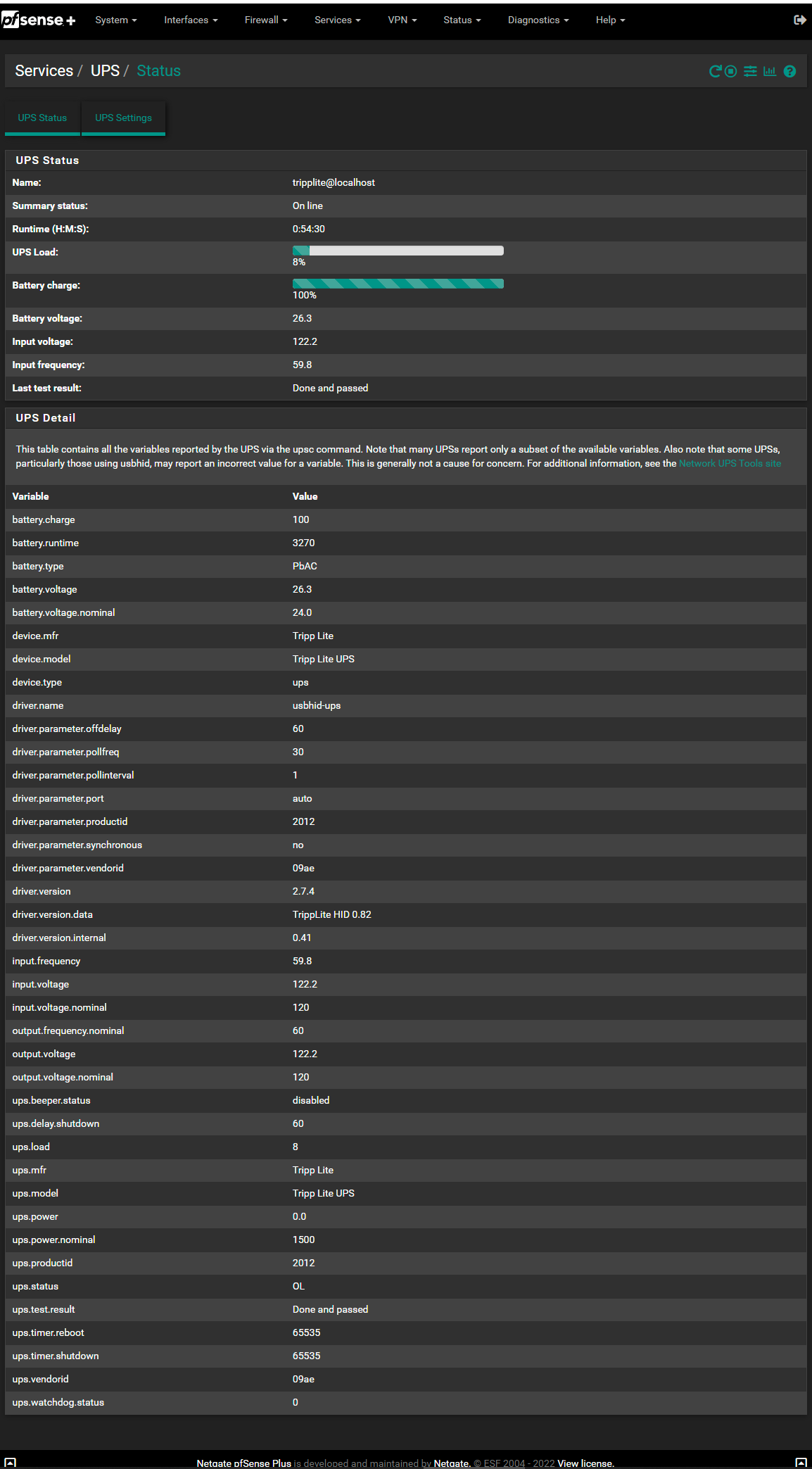
then ups.delay.shutdown reports 20 with setting offdelay=60 after 20mins or so.
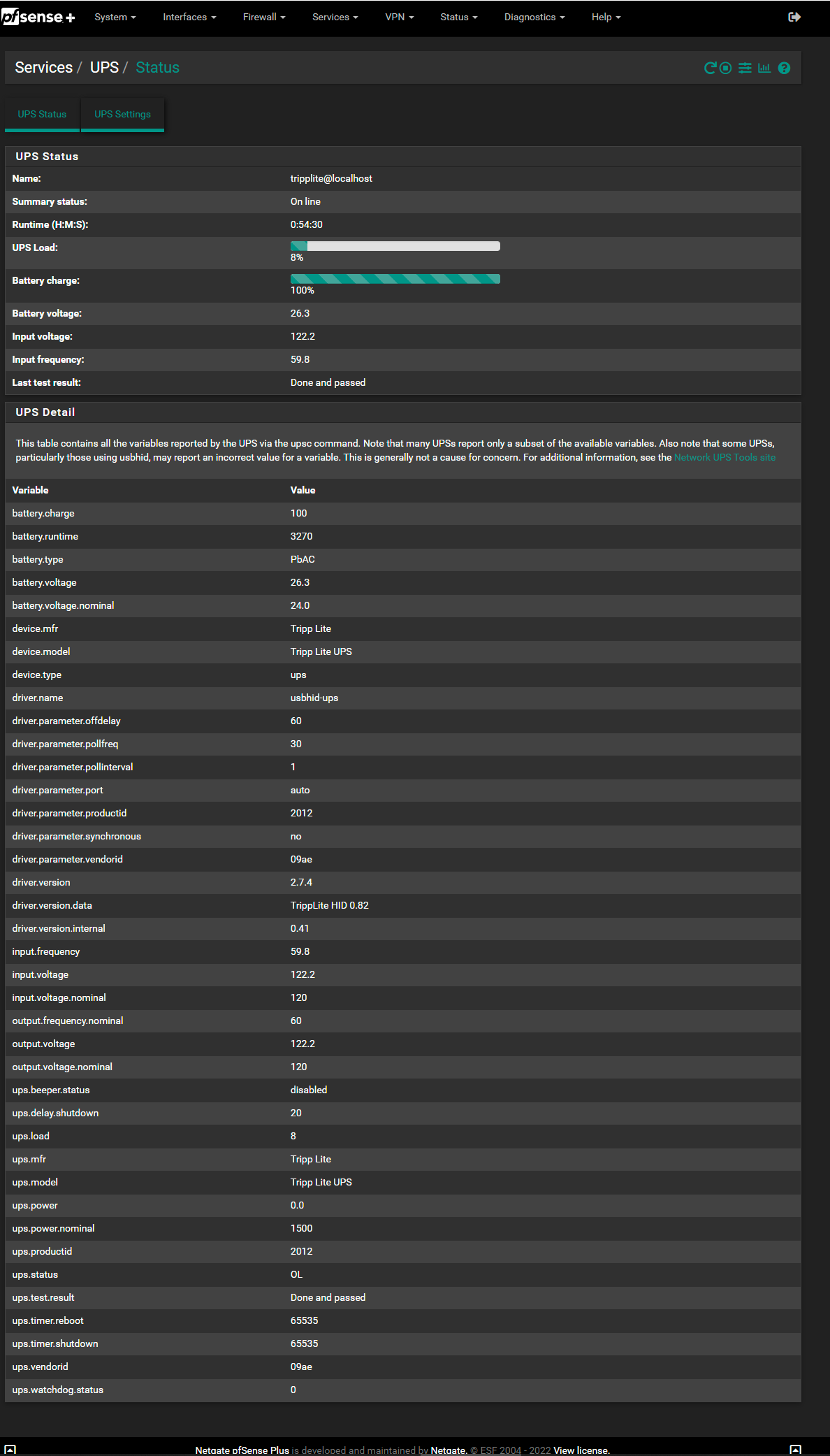
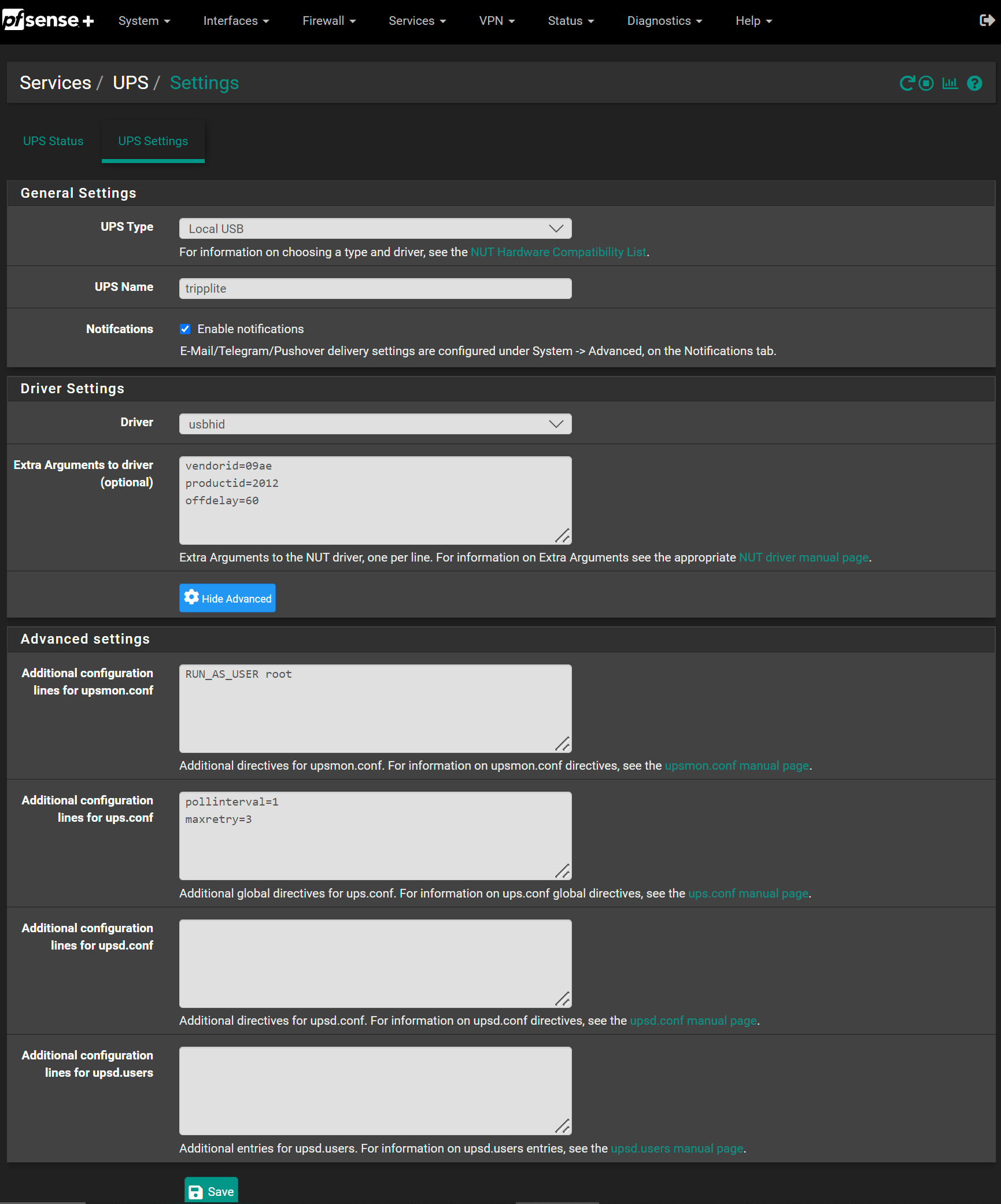
Please help!
-
Coincidentally, that is the exact UPS I used to initially develop the pfSense NUT package. It has been extensively tested.

I still have a few of them around, but none are connected to NUT at the moment, so I'm going off old memory...
First recommendation, get rid of everything you have in the Extra Arguments to driver section, and everything in the Advanced section. You don't need or want that stuff in the nut config.
Several of the things you are trying to set in the configuration need to be set in the UPS itself via the upsrw command:
- battery.charge.low
- ups.delay.shutdown
- ups.delay.start
Use upsrw without the -s option to see the list of variables available in your UPS.
-
upsrw tripplite [ups.delay.shutdown] Interval to wait after shutdown with delay command (seconds) Type: STRING Maximum length: 10 Value: 20I've tried running nut with no arguments in advanced setting and get the same results. I've also tried running nut with no arguments in advanced settings or Extra Arguments to driver and get the same results. Im convinced there is something wrong with this UPS.
I've run
upsrw -s ups.delay.shutdown=60 -u admin -p 7828770f3f0c7aaa299b tripplite@localhostmultiple times over the last few weeks without the desired results. Reply comes back with OK and ups.delay.shutdown changes to 60 on the UPS Status page but it doesnt change the behavior of the UPS.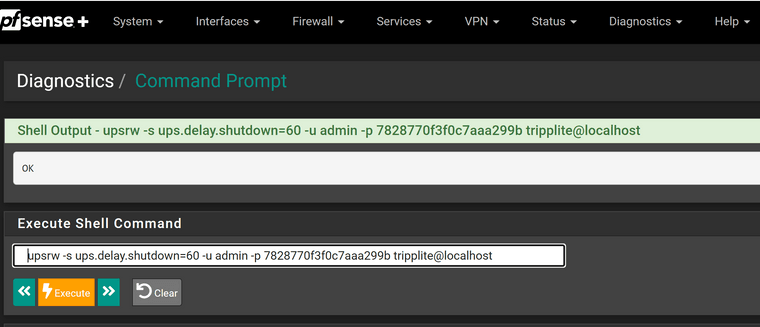
Even if
ups.delay.shutdownsome how worked and I used Extra Arguments to driverignorelbandoverride.battery.charge.low = 20oroverride.battery.runtime.low = 300to get pfSense to actually shut down I'd still have the issue of the UPS powering back up the outlets even though the main is off and running until the UPS battery completely dies. -
I just tested again. I wiped all settings. Then I added
ignorelbandoverride.battery.charge.low = 70to the Extra Arguments to driver field and saved.
Then I went to command line and ranupsrw -s ups.delay.shutdown=60 -u admin -p b6a197675f5b5b2e1334 tripplite@localhostwith the correct password and got theOKreply. I checked andups.delay.shutdowndisplayed60on the UPS status page.I cut the main... pfSense started shutting down at 70% battery charge. Before pfSense could fully shutdown the UPS killed power to the outlets for 20 seconds then restored power to them even though the main was off. Since pfSense wasnt able to fully shutdown it didnt start back up but my switch did. I had to pull the plug to my Netgate 1U firewall appliance for 60 seconds to let the power drain from the PSU to get it to boot again. UPS would have run until its battery completely drained.
-
@whoami-tm After loosing power and restarting, what do you see if you read the ups.delay.shutdown with upsrw? Perhaps it isn't saving to NVRAM? Or it could be overwritten at NUT startup.
-
@dennypage said in NUT package:
After loosing power and restarting, what do you see if you read the ups.delay.shutdown with upsrw?
ups.delay.shutdown goes back to the default of 20... Even without losing power and restarting ups.delay.shutdown goes back to the default of 20 after an hour or so.
-
@whoami-tm Okay, now add
offdelay=60 ondelay=90(and only that) in the Extra Arguments to driver section and repeat the test.
Copyright 2025 Rubicon Communications LLC (Netgate). All rights reserved.